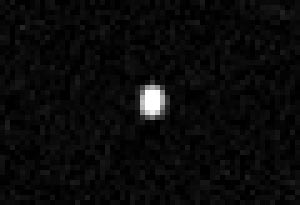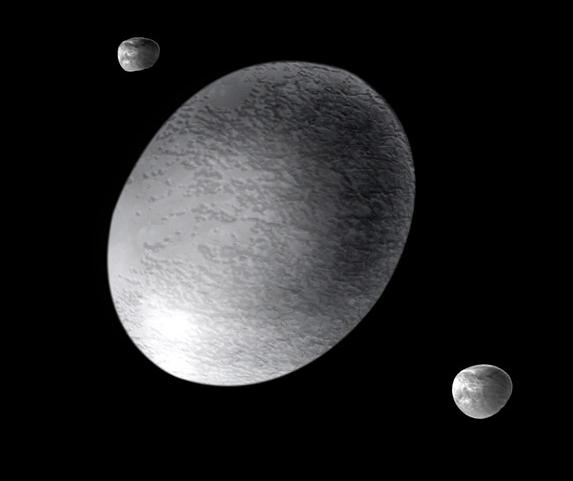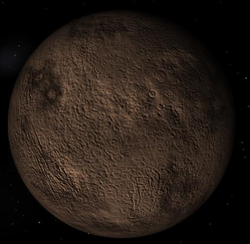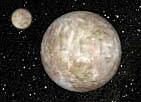By Alton Parrish.
Do you know how many planets and dwarf planets are in our solar system. I thought I did, but I didn’t.
Astronomers have detected over 500 bodies orbiting the sun well beyond the orbit of Neptune. Among these Trans-Neptunian Bodies (TNOs) are a growing number that rival Pluto in size. This caused astronomers to rethink how they should define the term planet.
In 2006 Pluto was demoted from a planet to a dwarf planet, joining the large asteroid Ceres in that new group. Several other TNOs also joined that group, which now includes five bodies shown highlighted in the table. A number of other large objects, called Plutoids, are also listed. The AU (astronomical unit) distance from the Earth to the Sun is one or 93 million miles (92,955,807.273 miles to be exact). Ceres which is between Jupiter and Mars was once considered the largest asteroid but is now considered a dwarf planet like Pluto.
Name AU Distance Years For Orbit
Credit: NASA
For the first time, in 2005 NASA’s Hubble Space Telescope distinctly saw the “tenth planet,” then nicknamed “Xena,” after the warrior princess in the TV show of the same name and found that it’s only slightly larger than Pluto. The announcement was made on March 11th, 2006. The name was later officially changed to Eris.
Eris, formerly known as Xena

Credit: NASA, ESA, and A. Schaller (for STScI)
Currently, Eris is more than three times farther from the Sun than Pluto. It is so cold out there that the dwarf planet’s atmosphere has frozen onto the surface as a frosty glaze. The coating gleams brightly, reflecting as much sunlight as fresh fallen snow. The path Eris takes around the Sun is shaped like an oval rather than a circle. In about 290 years, Eris will move close enough to the Sun to partially thaw. Its icy veneer will melt away revealing a rocky, speckled landscape similar to Pluto’s.
This is an artist’s concept of Kuiper Belt object Eris and its tiny satellite Dysnomia. Eris is the large object at the bottom of the illustration. A portion of its surface is lit by the Sun, located in the upper left corner of the image. Eris’s moon, Dysnomia, is located just above and to the left of Eris. The Hubble Space Telescope and Keck Observatory took images of Dysnomia’s movement from which astronomer Mike Brown (Caltech) precisely calculated Eris to be 27 percent more massive than Pluto.

Artwork Credit: NASA, ESA, Adolph Schaller (for STScI)
Aptly named after the Greek goddess of conflict, the icy dwarf planet Eris has rattled the general model of our solar system. The object was discovered by astronomer Mike Brown of Caltech in the outer reaches of the Kuiper belt in 2005. Its detection provoked debate about Pluto’s classification as a planet. Eris is slightly larger than Pluto. 
“Hubble is the only telescope capable of getting a clean visible-light measurement of the actual diameter of Eris,” said Mike Brown, planetary scientist at the California Institute of Technology in Pasadena, Calif. Brown’s research team discovered Eris, officially cataloged as 2003 UB313, and its results have been accepted for publication in the Astrophysical Journal.
Only a handful of images were required to determine Eris’ diameter. Located 10 billion miles from Earth with a diameter a little more than half the width of the United States, the object is 1.5 pixels across in Hubble’s view. That’s enough to make a precise size measurement.
Pluto’s diameter, as measured by Hubble, is 1,422 miles.
Located 10 billion miles away, but with a diameter that is a little more than half the width of the United States, Xena is only 1.5 picture elements across in Hubble’s Advanced Camera for Surveys’ view.

Eris’ bright reflectivity is possibly due to fresh methane frost on its surface. The object may have had an atmosphere when it was closer to the sun, but as it moved to its current location farther away this atmosphere would have “frozen out,” settling on the surface as frost.
Another possibility is that Eris leaks methane gas continuously from its warmer interior. When this methane reaches the cold surface, it immediately freezes solid, covering craters and other features to make it uniformly bright to Hubble’s telescopic eye.
Eris takes about 560 years to orbit the sun, and it is now very close to aphelion (the point on its orbit that is farthest from the sun). Brown next plans to use Hubble and other telescopes to study other recently discovered Kuiper Belt objects that are almost as large as Pluto and Eris. The Kuiper Belt is a vast ring of primordial icy comets and larger bodies encircling Neptune’s orbit.


Sedna Mystery Deepens With Hubble Images Of Farthest Planetoid
Astronomers studying 35 NASA Hubble Space Telescope (HST) images of the solar system’s farthest known object, unofficially named Sedna, are surprised the object does not appear to have a companion moon of any substantial size.
This unexpected result might offer new clues to the origin and evolution of objects on the far edge of the solar system.
Sedna’s existence was announced on March 15. Its discoverer, Mike Brown of the California Institute of Technology, Pasadena, Calif., was so convinced it had a satellite, that an artist’s concept of Sedna released to the media included a hypothetical moon.

Even with Hubble’s crisp view, it may just be barely resolving the disk of mysterious Sedna, Brown said. It’s equivalent to trying to see a soccer ball 900 miles away. This would place an upper limit in the object’s size of being approximately three-quarters the size of Pluto, or about 1,000 miles across.
But Brown predicted a satellite would pop up as a companion “dot” in Hubble’s precise view. But the object is not there. There is a very small chance, it might have been behind Sedna or transiting in front of it, so it could not be seen separately from Sedna in the HST images.
Brown based this prediction on his earlier observations of apparent periodic changes in light reflecting from Sedna’s mottled surface. The resulting light curve gives a rotation period of 40 days. If true, Sedna would be the slowest rotating object in the solar system after Mercury and Venus, whose slow rotation rates are due to the tidal influence of the sun.
One easy way out of this dilemma is the possibility the rotation period is not as slow as astronomers thought. But even with a careful reanalysis, the team remains convinced the period is correct. Brown admits, “I’m completely lost for an explanation as to why the object rotates so slowly.”
Small bodies like asteroids and comets typically complete one rotation in a matter of hours. Pluto has a six-day period from being tidally locked to the revolution of its satellite Charon. The HST was the first telescope to resolve Pluto and Charon as two separate bodies. NASA’s forthcoming James Webb Space Telescope will provide a platform for further high-resolution studies of infrared light from such distant, cold bodies in our solar system.
Electronic images of Sedna and additional information are available on the Internet, at:
http://hubblesite.org/news/2004/14
Quaoar
NASA’s Hubble Space Telescope has measured the largest object in the solar system seen since the discovery of Pluto 72 years ago. The discovery was made October 7, 2002
Approximately half the size of Pluto, the icy world 2002 LM60, dubbed “Quaoar” (pronounced kwa-whar) by its discoverers, is the farthest object in the solar system ever to be resolved by a telescope. It was initially detected by a ground-based telescope as simply a dot of light, until astronomers aimed Hubble’s powerful telescope at it.
Quaoar is about 4 billion miles away from Earth, well over a billion miles farther away than Pluto. Unlike Pluto, its orbit around the Sun is circular, even more so than most of the planetary-class bodies in the solar system.

Credit: NASA/HST
Although smaller than Pluto, Quaoar is greater in volume than all the asteroids combined (though probably only one-third the mass of the asteroid belt, because it’s icy rather than rocky). Quaoar’s composition is theorized to be largely ices mixed with rock, not unlike the makeup of a comet, though 100 million times greater in volume.
This finding yields important new insights into the origin and dynamics of the planets, and the mysterious population of bodies dwelling in the solar system’s final frontier: the elusive, icy Kuiper Belt beyond Neptune.
Michael Brown and Chadwick Trujillo of the California Institute of Technology, Pasadena, Calif. are reported the findings at the 34th annual meeting of the Division for Planetary Sciences of the American Astronomical Society in Birmingham, Ala. 50000 Quaoar (“Kwawar”) is a rocky trans-Neptunian object in the Kuiper belt with one known moon. Several astronomers consider it to be a dwarf planet, although the IAU has not formally recognized it as one.
Trujillo and Brown used the Palomar Oschin Schmidt telescope to discover Quaoar as an 18.5-magnitude object creeping across the summer constellation Ophiuchus (it’s less than 1/100,000 the brightness of the faintest star seen by the human eye). Brown had to do follow-up observations using Hubble’s new Advanced Camera for Surveys on July 5 and August 1, 2002, to measure the object’s true angular size of 40 milliarcseconds, corresponding to a diameter of about 800 miles (1300 kilometers). Only Hubble has the sharpness needed to actually resolve the disk of the distant world, leading to the first-ever direct measurement of the true size of a Kuiper Belt Object (KBO).
Like Pluto, Quaoar dwells in the Kuiper Belt, an icy debris field of comet-like bodies extending 7 billion miles beyond Neptune’s orbit. Over the past decade more than 500 icy bodies have been found in the Kuiper Belt. With a few exceptions all have been significantly smaller than Pluto.
This latest large KBO is too new to have been officially named by the International Astronomical Union. Trujillo and Brown have proposed naming it after a creation god of the Native American Tongva tribe, the original inhabitants of the Los Angeles basin. According to legend, Quaoar “came down from heaven; and, after reducing chaos to order, laid out the world on the back of seven giants. He then created the lower animals, and then mankind.”
Quaoar’s “icy dwarf” cousin, Pluto, was discovered in 1930 in the course of a 15-year search for trans-Neptunian planets. It wasn’t realized until much later that Pluto actually was the largest of the known Kuiper Belt objects. The Kuiper Belt wasn’t theorized until 1950, after comet orbits provided telltale evidence of a vast nesting ground for comets just beyond Neptune. The first recognized Kuiper Belt objects were not discovered until the early 1990s. This new object is by far the “biggest fish” astronomers have snagged in KBO surveys. Brown predicts, within a few years, even larger KBOs will be found, and Hubble will be invaluable for follow-up observations to pin down sizes.
Orbits of Makemake (blue), Haumea (green), contrasted with the orbit of Pluto (red) and the ecliptic (grey). The perihelia and the aphelia (Q) are marked with the dates of passage. The positions on April 2006 are marked with the spheres illustrating relative sizes and differences in albedo and colour.
Credit: NASA
Makemake (2005 FY9)
Makemake, formally designated (136472) Makemake, is a dwarf planet and perhaps the largest Kuiper belt object (KBO) in the classical population,[nb 4] with a diameter that is probably about 2/3 the size of Pluto. Makemake has no known satellites, which makes it unique among the largest KBOs and means that its mass can only be estimated. Its extremely low average temperature, about 30 K (−243.2 °C), means its surface is covered with methane, ethane, and possibly nitrogen ices.


Keck image of Haumea and its two moons. Hiʻiaka is above Haumea (centre), and Namaka is directly below.


Haumea is the largest member of its collisional family, a group of astronomical objects with similar physical and orbital characteristics thought to have formed when a larger progenitor was shattered by an impact. This family is the first to be identified among TNOs and includes—beside Haumea and its moons
Huya

Orcus

2007 OR10
2007 OR10 is a very large trans-Neptunian object. It is the largest body in the Solar System without a name, estimated to be between Haumea and Sedna in size. Its mass has never been measured, and its diameter is not well determined. It has not been formally recognized as a dwarf planet by the IAU, although some astronomers consider it to be one and others consider it likely to be one.

Varuna
Varuna and an object called 2002 AW197 are each approximately 540 miles across (900 kilometers). Unlike dimensions derived from Hubble’s direct observations, these diameters are deduced from measuring the objects’ temperatures and calculating a size based on assumptions about the KBOs’ reflectivity, so the uncertainty in true size is much greater.

Ixion
Ixion was originally discovered on May 22, 2001, by a group of American astronomers lead by Robert L. Millis of the Lowell Observatory in Flagstaff, Arizona. (M. Buie (Lowell), E. Chiang (IAS), J. Elliot (MIT), S. Kern (MIT), D. Trilling (U. Penn.), R. M. Wagner (LBT Obs.), L. H. Wasserman (Lowell)]. Furthering this work, Finnish and Swedish astronomers, using the La Silla Observatory in Chile, calculate Ixion to have a diameter of about 1065 ±165 kilometers. Thus, Ixion is similar in size to Ceres (the largest of the four primary asteroids and also now considered a dwarf planet) and is one of the brightest of the Kuiper objects. Ixion’s orbital period is 250.05 years and it has a 19.598° orbital inclination

This diagram shows the orbits of Ixion (green), Pluto (red) and Neptune (grey). The current positions of Ixion and Pluto are indicated (as of April 2006).

Kuiper Belt objects
Finding that the largest known Kuiper Belt object is a virtual twin to Pluto may only further complicate the debate about whether to categorize the large icy worlds that populate the belt as planets. If Pluto were considered to be the minimum size for a planet, then Xena would fulfill this criterion, too. In time, the International Astronomical Union will designate the official name.
The image shows the relative sizes of the largest known Kuiper Belt Objects, including Pluto and its moon, Charon.

Credit: ESO


